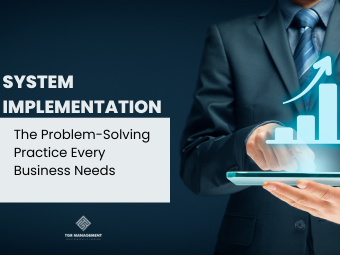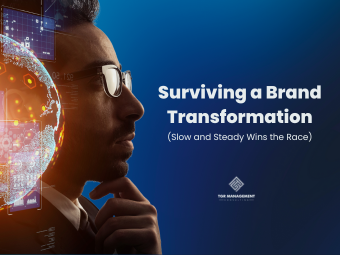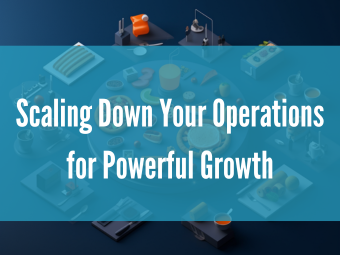
On some level, we’re all looking for one easy answer that’ll make surmounting the many challenges we face as managers easier. The problem is–there is no easy answer. But fortunately, there are best practices. One such practice I love to discuss is developing and implementing systems within your organization.
You may be tempted to groan; I get it if you are rolling your eyes right now. System implementation is fun for some. For others, it’s another process change that causes them to wake up sweating. This perception of systems as yet another “annoying task” stems from a lack of understanding. Systems aren’t supposed to be unknowable mechanisms that require constant maintenance. They’re supposed to make your life easier.
You may be surprised to realize that, as a business owner, you’ve already developed and implemented several systems.
Systems You Know
Systems are not necessarily software tools; they’re a way of managing tasks. There may be technology or tools associated with it, but we’re talking about the process today. Payroll, Marketing, Sales, and Operations are all examples of systems you use daily. As a CEO, you may have had a direct hand in developing these systems, or there may be someone you hired with experience in these departments to build and manage these systems for you.
A well-organized system saves you time and energy – and an automated system takes that a step further. You don’t pull out a calculator every time you process payroll (at least, I hope you don’t!). There are services like Gusto, Harvest, Paychex, etc. All these require is a one-time setup: afterward, you simply review and approve. Suddenly, the time and energy you were using to process payroll can be redirected elsewhere.
Well-Organized Systems
You should be able to quickly identify and fix any problems within your system that occur. Think of a vacuum. A good vacuum cleaner does one thing: it picks up dust and locks it into a chamber. But what happens when there’s a blockage? Ideally, a well-designed vacuum will account for jams. You’ll be able to find the problem and remove it quickly.
So it is with business! You can’t assume that you won’t run into problems. Your system needs to be organized and flexible so you can quickly identify the source of the issue, address it, and get back to business.
Lasagna Love – A System Success Story
Last year, The Business of Non-Profits Podcast featured one of my favorite non-profits: Lasagna Love. Lasagna Love is run by founder and CEO Rihannon Lynn, whose background in business and an understanding of the importance of solid and flexible systems contributed directly to the organization’s success. They create delicious homemade meals which are distributed to families who need them.
From the beginning, they were considering a technology solution. Scheduling systems, management systems: ways to make the whole structure easier, faster, and more efficient. Every time they faced a question, they didn’t just find an answer: they built a system around it. This freed up their time: instead of constantly handling one-off problems, they already had systems in place.
But it wasn’t just developing systems; implementing technology solutions to assist system implementation was an essential aspect of their success.
They started on Google Sheets, but due to their explosive growth, they realized they’d need more. Rhiannon took the first step and asked her volunteers for help. With that help, they developed their online portal. This portal allowed volunteers to step in and update information and pose questions live. Essentially, the portal runs itself. Because of this new technology combined with the existing systems, they could maintain their organization while experiencing exponential growth – not an easy task when working with volunteers!
No System is Perfect.
I cannot stress the importance of flexibility enough. Humans are inherently imperfect, so no system developed by or run by us will be without error. With that in mind, you must incorporate two things in your implementation plan to ensure your system is healthy. Lasagna Love implements both. One is building systems that are flexible enough to be reshaped easily and as needed. The other is system analysis. You should regularly assess, measure, and determine if the systems and processes you have in place continue to work as you scale.
In the podcast episode I mentioned earlier, Rhiannon talks about how they hit their milestone of feeding 1,000,000 people in July 2022. She goes on to explain how they needed to take a pause and reassess systems. They’ve grown from a 1-person movement to an organization of thousands. They’re even branching out to different countries. Rhiannon understands that to continue this success and growth, the systems they have in place will have to change and grow with the organization.
Tech Vs. Manpower: The Eternal Debate
There are so many mistakes an organization can make regarding integrating technology into their system development. Generally, the mistake I see most often is failing to balance technology and people while developing an implementation plan. Lasagna Love found their balance.
They could have implemented technical solutions and systems at the expense of the comfort and success of their volunteers. Alternatively, they could have dismissed the need for technology and systems entirely, thinking that the sheer number of volunteers and resources would be enough to solve any problems they encountered. Instead, Lasagna Love struck the balance of implementing technology while considering the people within the movement.
Rhiannon asked for help when she developed their portal. She treated her volunteers as customers by considering their direct feedback and experiences throughout the portal’s development. She understood who the portal was for and how it would need to be developed to ensure that volunteers and recipients could use it. She took a step toward developing and implementing a technology-based solution without losing touch with the people who would be directly affected by it.
Systems as Saviors
If you listen to The Business of Non-Profits Podcast (and I strongly recommend you do), you’ll hear Rhiannon recommend you incorporate system implementation as early on in the process as possible. If you’re not inclined toward creating and implementing systems, getting someone on your team who is comfortable with it can ensure success.
You can’t account for every problem your business will encounter and can’t always throw resources at challenges to make them disappear. A well-organized, automated, flexible system is the cornerstone of every highly successful business. Successful system implementation is your best bet for success!
Tiffany Rosik, founder and CEO of TGR Management Consulting, advises Fortune 1000 companies on aligning business and technology initiatives to achieve growth. Tiffany goes beyond project best practices by coaching Project Team Leaders on team dynamics and techniques to establish a self-sustaining model that creates a consistent experience and produces results. Connect or follow Tiffany Rosik on LinkedIn.




